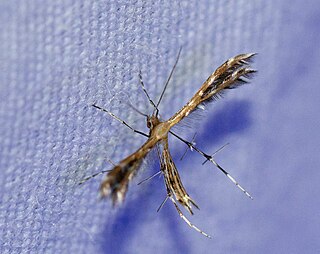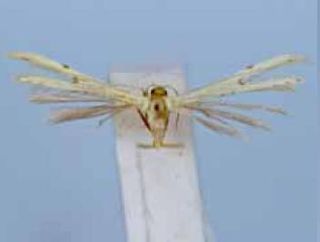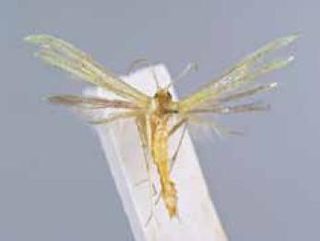
The Pterophoridae or plume moths are a family of Lepidoptera with unusually modified wings, giving them the shape of a narrow winged airplane. Though they belong to the Apoditrysia like the larger moths and the butterflies, unlike these they are tiny and were formerly included among the assemblage called "microlepidoptera".

Pterophorus pentadactyla, commonly known as the white plume moth, is a moth in the family Pterophoridae. It is found in the West Palearctic including North Africa and Europe. The wingspan is 26–34 mm (1.0–1.3 in). It is uniformly white, with the hind wing pair divided in three feathery plumes and the front pair in another two. The moths fly from June to August. The larvae feed on bindweed.

Sphenarches anisodactylus, commonly known as the geranium plume moth, is a species of moth in the family Pterophoridae. It is found in western Africa, Madagascar, India, Sri Lanka, Thailand, Japan, the New Hebrides and Central and South America, as well as Australia, where it has been recorded from Cape York to central New South Wales. It is found in the United States, where it has been recorded from Florida, as well as Mississippi. It is also present in the Kermadec Islands of New Zealand.
Stenoptilia pallistriga is a moth of the family Pterophoridae described by William Barnes and James Halliday McDunnough in 1913. It is known from Dominica, Ecuador, Jamaica, Paraguay and Suriname. It is also found in the United States in Florida and Mississippi.
Trichoptilus pygmaeus is a moth of the family Pterophoridae. It is found in North America, including California, Florida and British Columbia.

Dejongia californicus is a moth of the family Pterophoridae. It is found in North America, including California and the south-eastern United States.

Buckleria parvulus, the sundew plume moth, is a moth of the family Pterophoridae. The species was first described by William Barnes and Arthur Ward Lindsey in 1965 from Archbold Biological Station, Florida. It is found in the south-eastern United States, including Florida, North Carolina, Louisiana, Alabama, Georgia, Mississippi, South Carolina and Texas.
Paraplatyptilia carolina is a moth of the family Pterophoridae described by William D. Kearfott in 1907. It is found in the southeastern United States, including Florida, southern Mississippi, North Carolina and Georgia.
Paraplatyptilia auriga is a moth of the family Pterophoridae described by William Barnes and Arthur Ward Lindsey in 1921. It is found in eastern North America, including Florida, Mississippi, and New Jersey.

Adaina bipunctatus is a moth of the family Pterophoridae. It is found in the United States, including Florida and Mississippi. It has also been recorded from Trinidad, the West Indies, Brazil and Ecuador.
Hellinsia unicolor is a moth of the family Pterophoridae described by William Barnes and James Halliday McDunnough in 1913. It is found in North America, including Florida, Mississippi, Georgia and Kentucky.
Hellinsia glenni is a moth of the family Pterophoridae described by Everett D. Cashatt in 1972. It is found in North America, including Florida, Mississippi and California.
Hellinsia lacteodactylus is a moth of the family Pterophoridae described by Vactor Tousey Chambers in 1873. It is found in North America, including Florida, Mississippi, Kentucky, North Carolina, Colorado, Nova Scotia and British Columbia.

Hellinsia paleaceus is a moth of the family Pterophoridae described by Philipp Christoph Zeller in 1873. It is found in North America, including Florida, Mississippi Maryland, Montana, Texas, California, Nebraska, New Mexico and south-eastern Canada. It has also been recorded from Puerto Rico.

Hellinsia inquinatus is a moth of the family Pterophoridae. It is found in North America, including Florida, Mississippi, Oklahoma, Tennessee, Maryland, Alabama, Texas, Missouri, Colorado and Arizona. It has also been recorded from Hispaniola, Mexico, Puerto Rico and St. Thomas Island.

Oidaematophorus eupatorii, the eupatorium plume moth or Joe Pye plume moth, is a moth of the family Pterophoridae. It is found in North America, including Florida, Mississippi, Iowa, New York, California and Vancouver Island. It is also known from Mexico, Guatemala and Panama.

Adaina simplicius is a moth of the family Pterophoridae. It is found in the United States, Brazil, Costa Rica, Ecuador, Paraguay and Puerto Rico. It was introduced to South Africa for study as a biological control agent for Eupatorium macrocephalum.

Adaina primulacea is a moth of the family Pterophoridae. It is known from Taboga Island in the Gulf of Panama, Costa Rica and southern Florida, United States. It is probably widespread throughout the Neotropics, including the West Indies and Central and South America.
Hellinsia helianthi is a moth of the family Pterophoridae. It is found in North America in California, Colorado, British Columbia and Alberta.
Oidaematophorus occidentalis is a moth of the family Pterophoridae. It is found from Alberta and British Columbia to Arizona and Utah.











